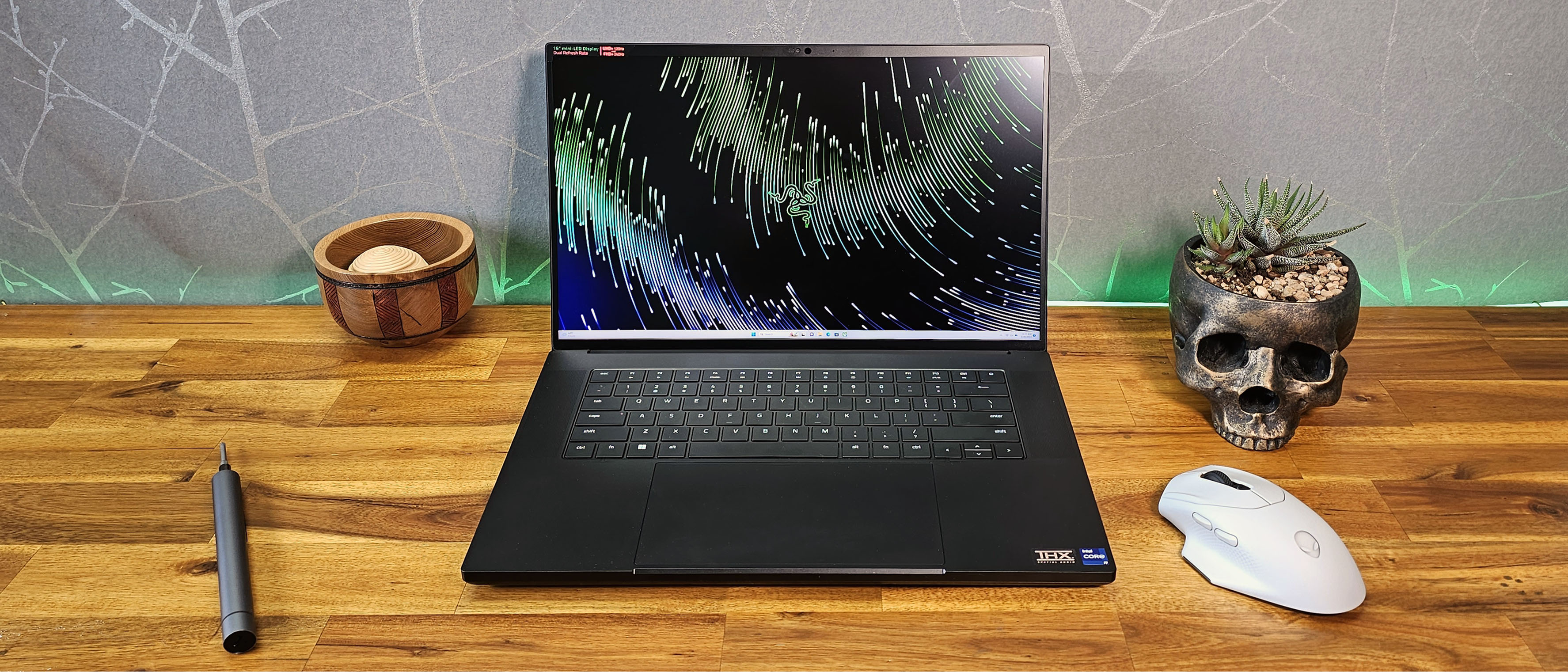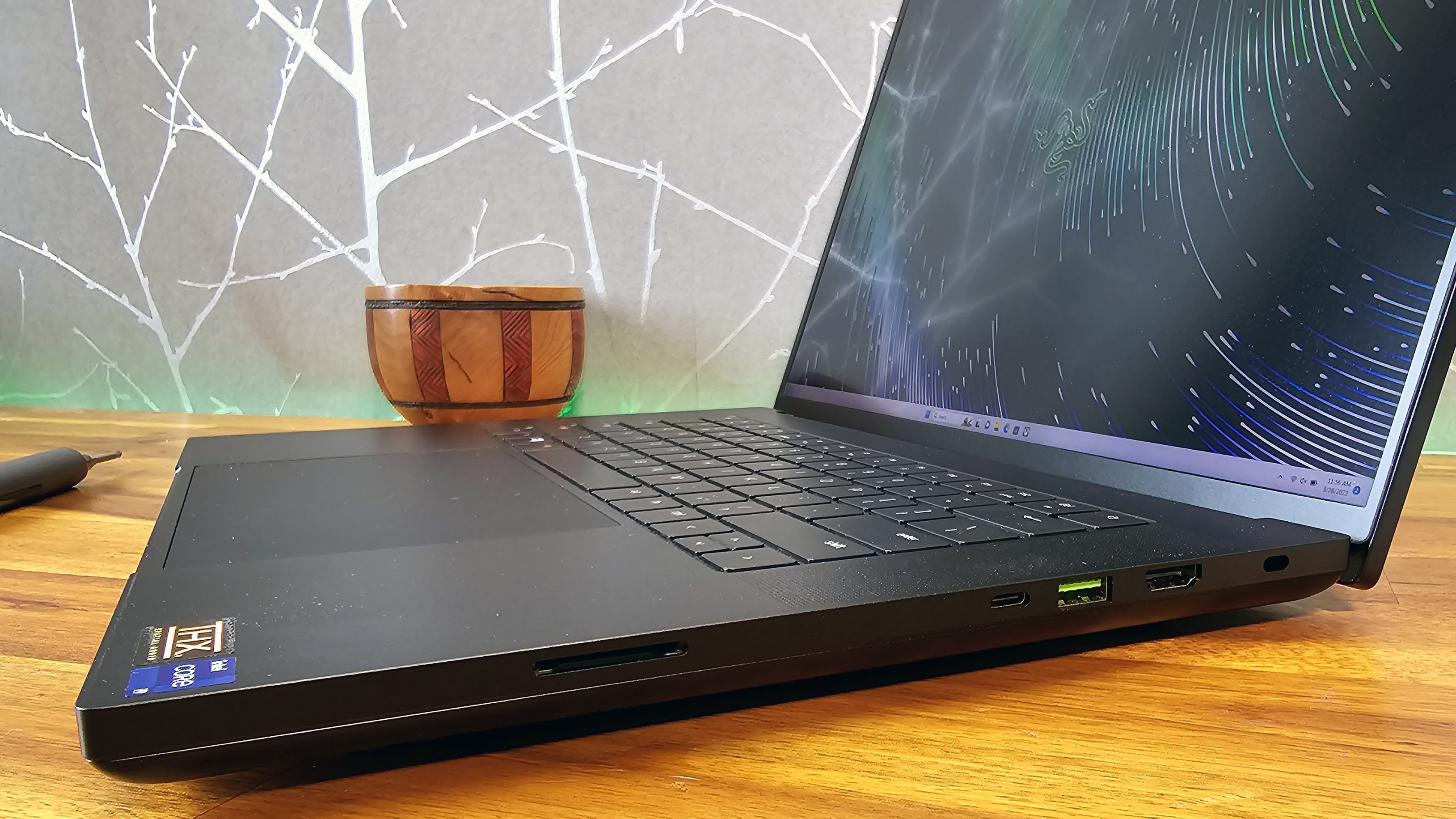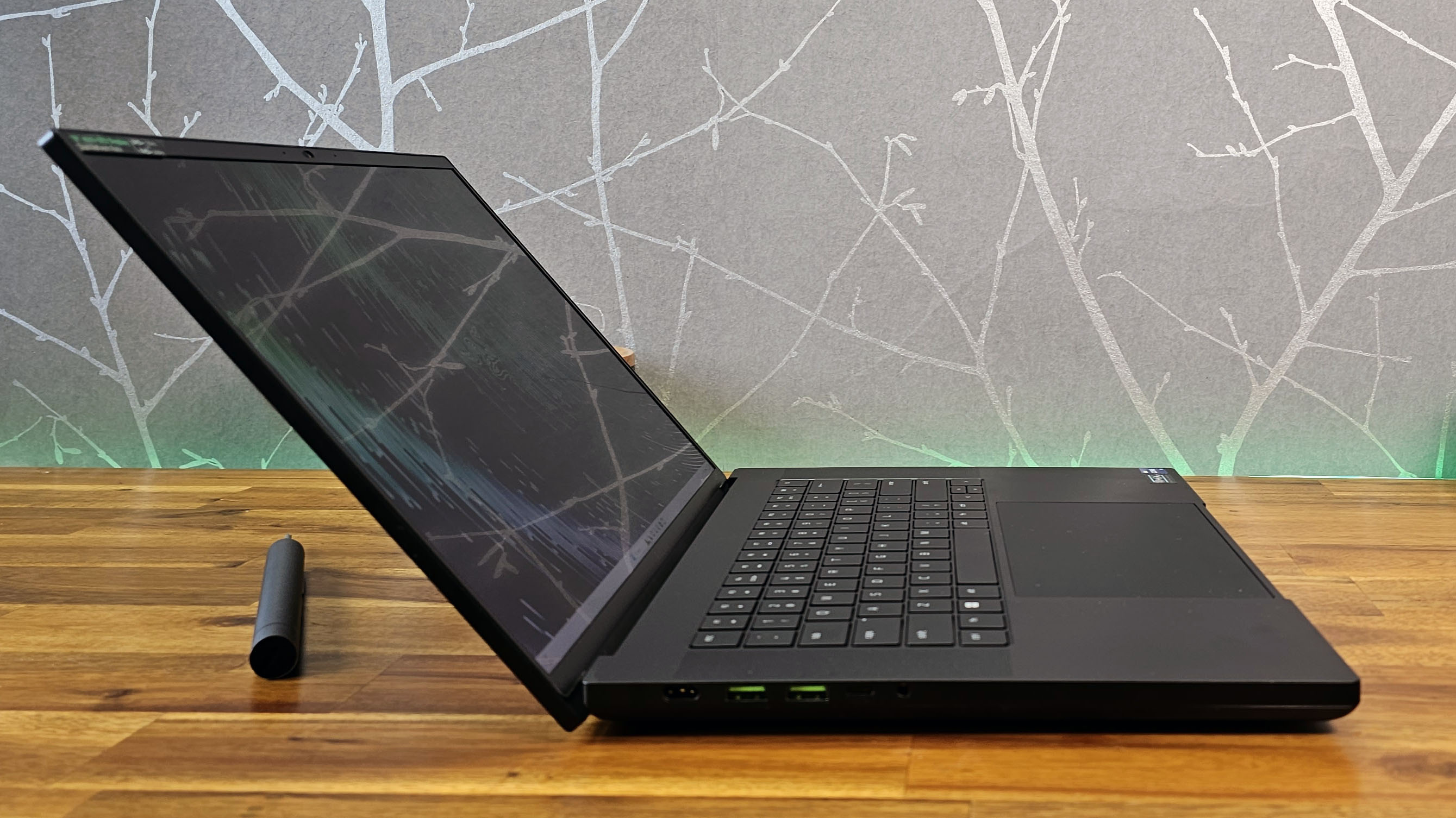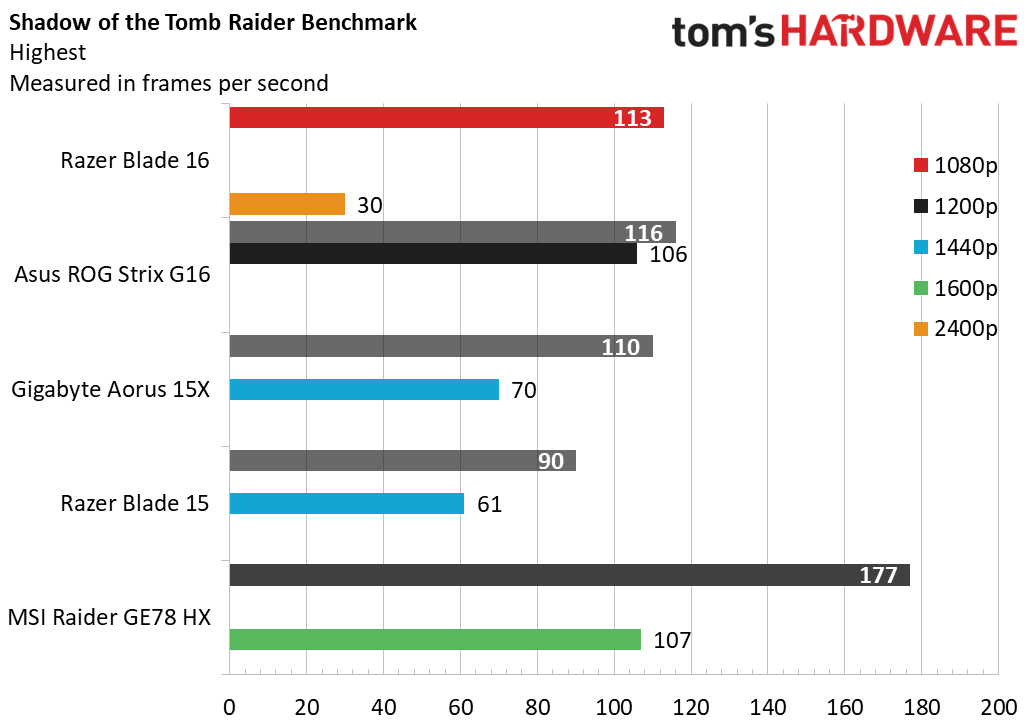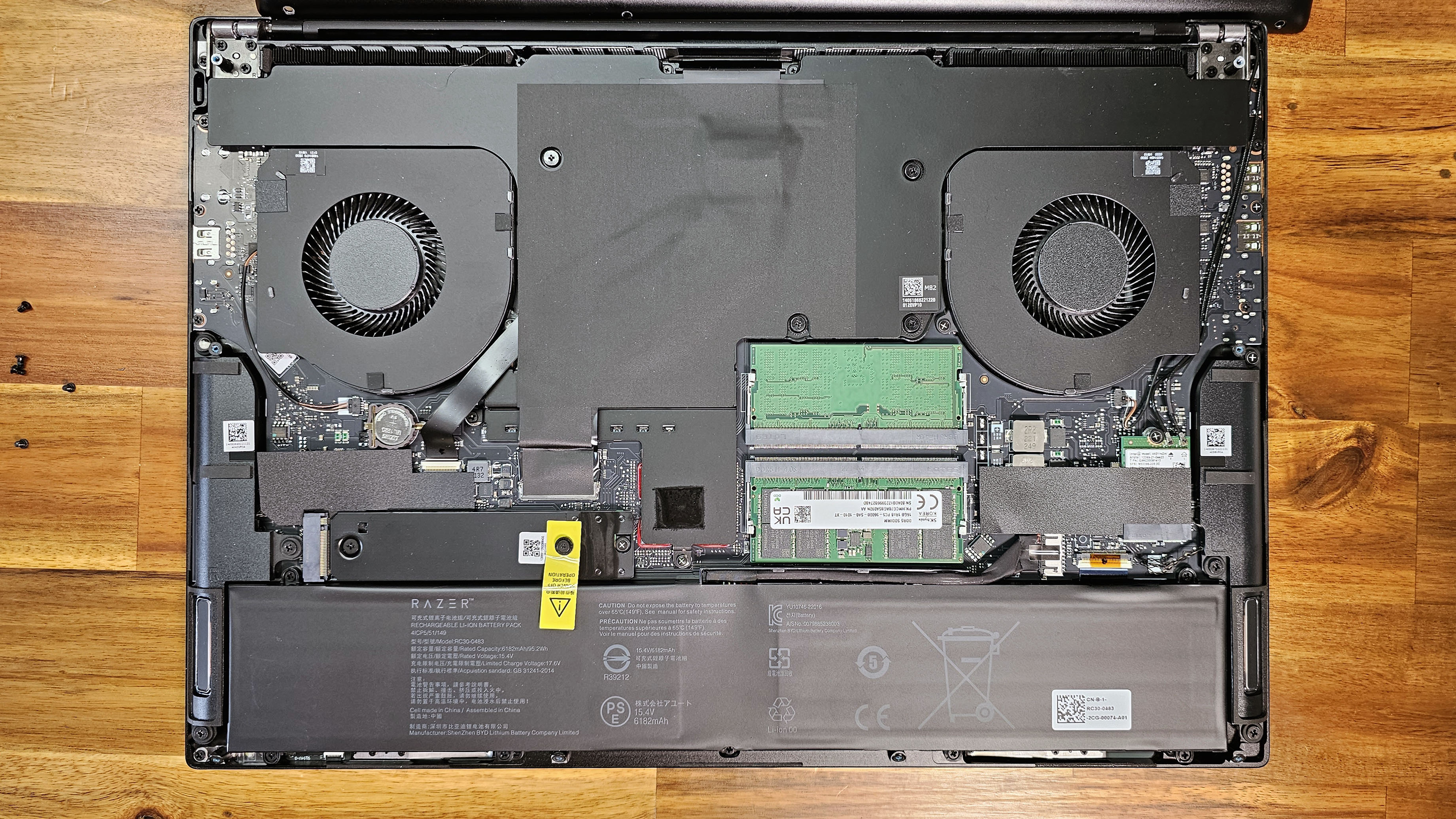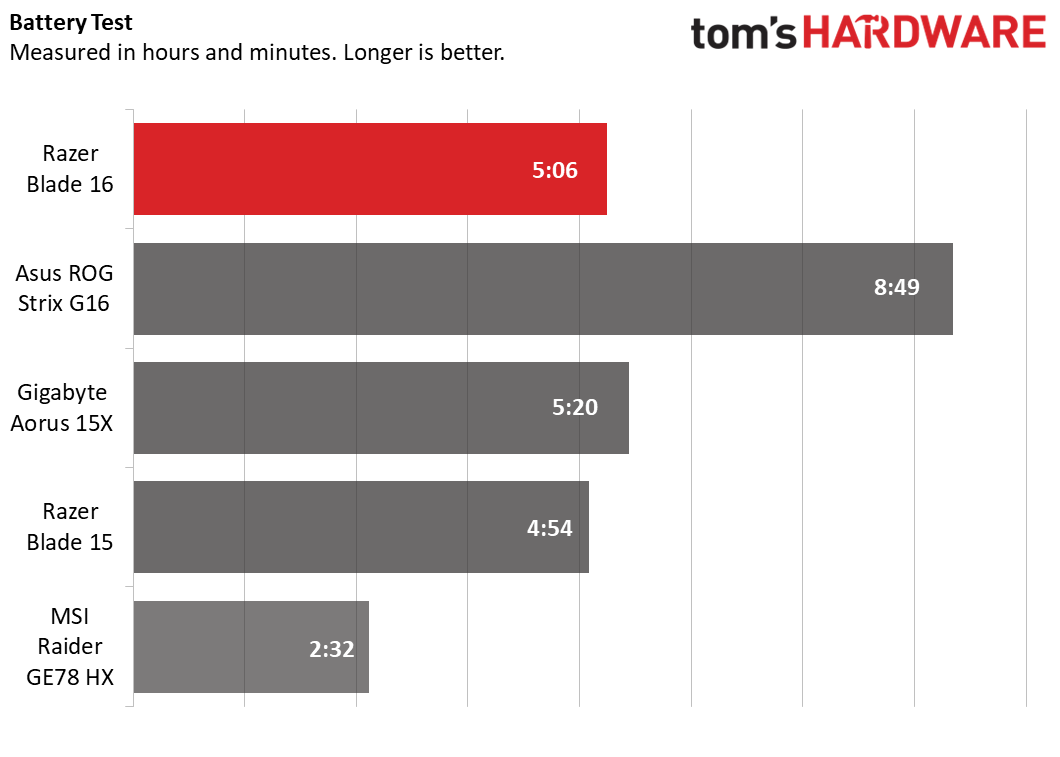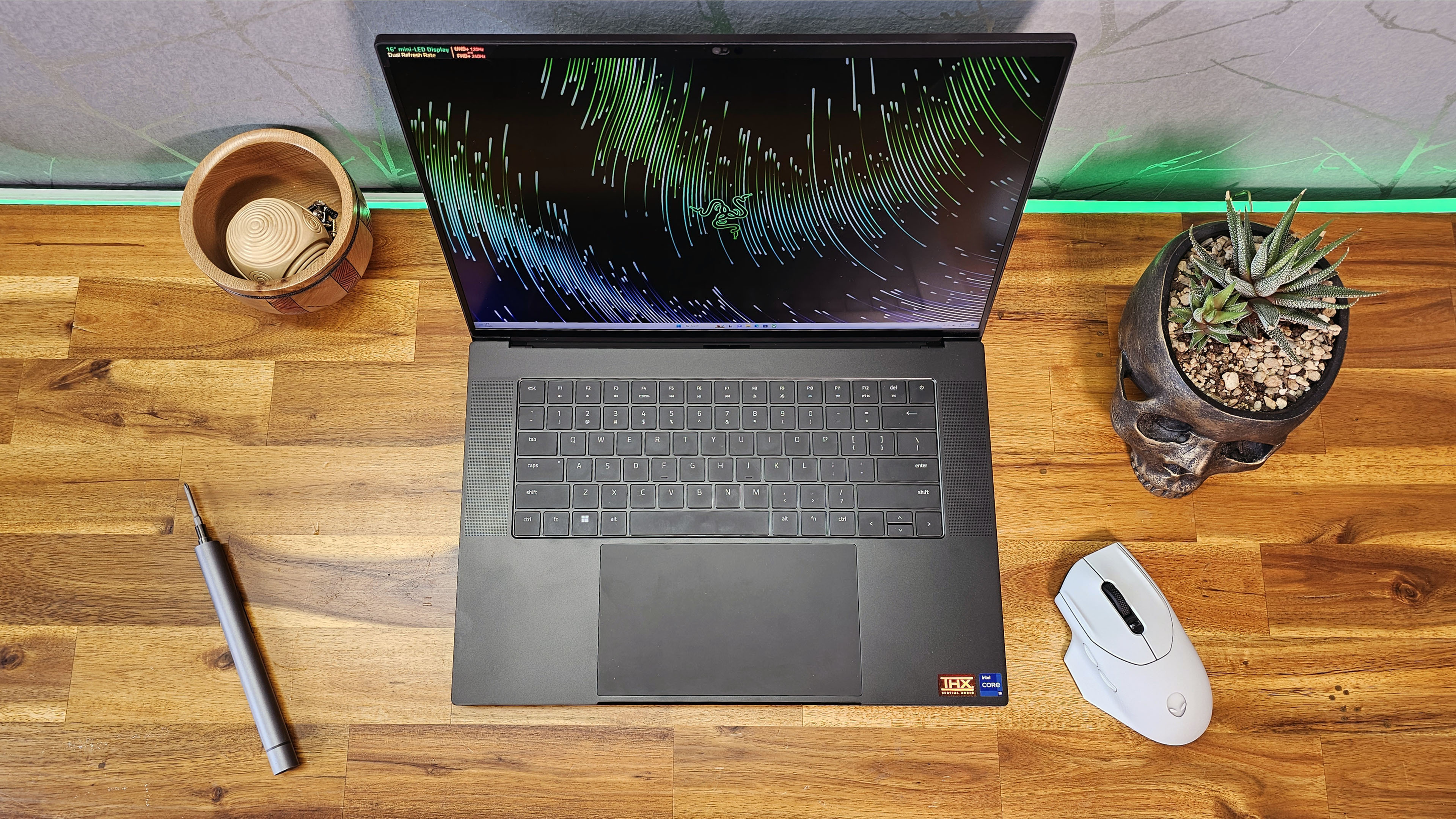Tom's Hardware Verdict
The Blade 16 is an attractive, premium gaming laptop with a gorgeous and unique Mini-LED dual-mode display. But you're paying a whole lot for the display and design, as similarly performing systems can be found for more than $1,000 less.
Pros
- +
Great Mini-LED screen
- +
Strong port selection
- +
Good 1080p Webcam
Cons
- -
Extremely expensive
- -
Reboot required for dual-mode resolution / refresh change
Why you can trust Tom's Hardware
Razer's Blade laptops have always prioritized slick looks and premium build quality over affordability. That's true of the company's latest laptops as well, which retain their understated black metal shells and per-key RGB keyboards, while acquiescing to the industry trend of taller 16:10 displays. That means a name change to the Blade 16 (which we're looking at here) and Blade 18. Both technically bigger, but mostly just taller/deeper front to back than their Blade 15 and Blade 17 forebearers, while also updating to 13th Gen Intel and 40-series Nvidia silicon options.
The Blade 16 in particular also delivers a stunning Min-LED dual-mode display that can switch between 3840 x 2400 at 120 Hz refresh rate, or 1920 x 1200 at a swifter 240 Hz for faster-paced gaming. It's an interesting move to placate both esports and AAA gamers (who are often one and the same), and the display looks gorgeous. But whether due to the display tech or not, battery life isn't the best. And starting at $2,699 with an RTX 4060 and bumping up to $3,299 in our review config (RTX 4070, Core i9-13950HX, 32GB of RAM), the Blade 16 is a tough sell when alternatives with similar silicon, like Asus' ROG Strix G16, sell for $1,999 with a better CPU and the same graphics card.
At the very least, if you opt for the Blade 16, know you're paying a substantial premium for a great display and Razer's all-metal chassis design. If you mostly just care about gaming performance, there are similarly performing options that cost quite a lot less.
Design of the Razer Blade 16
Aside from the move to a taller 16:10 display, not a ton has changed on the outside of the Blade 16 compared 2022's Blade 15. You get the understated but attractive all-black metal shell that the company is known for. If it weren't for the green backlit snake logo on the lid, it wouldn't look out of place in an office. I definitely prefer this design over flashier gaming laptops with RGB light bars and contrasting materials. But if you do want to add some visual wow factor when you're away from school or the office, the Blade 16's keyboard is still per-key RGB backlit.
The laptop is thicker than it used to be at 13.98 x 9.61 x 0.87 inches, compared to the Blade 15's 13.98 x 9.25 x 0.67 inches. Asus' Strix G16 is ever so slightly thicker, at 13.94 x 10.39 x 0.89 inches, and weighs 5.51 pounds, which is also slightly more than the 5.4-pound Blade 16. There is definitely some added heft that comes with the taller screen (and there's now support for up to an RTX 4090), because the last-gen Blade 15 is a pound lighter, at 4.4 pounds.
The other big change, literally, is the touchpad. It's still a pleasingly slick glass surface, but it's been enlarged from 5.1 inches diagonally on the Blade 15, to 7.5 inches diagonally on the Blade 16, seemingly to fill the larger keyboard deck that results in the move to a larger 16:10 display. We'll discuss the touchpad more below.
Port selection remains excellent, with the right edge sporting an SD card slot, a USB-A and a USB-C port (both 10 Gbps USB 3.2 Gen 2), a full-size HDMI 2.1 port and a lock slot.
The left edge houses two more USB-A ports, a Thunderbolt 4 (USB-C) port, a headphone jack and Razer's proprietary power connector for the included 280W GaN charger. The USB-C ports also support charging up to 100W if you want to charge that way. You'll still need the power brick, though, to game and charge at full speed.
Razer Blade 16 Specs
| CPU | Intel Core i9-13950HX |
| Graphics | Nvidia GeForce RTX 4070 (8GB GDDR6, 2,225 MHz Boost Clock, 115 W Max Graphics Power) |
| Memory | 32GB DDR5-5600 (2x 16GB) |
| Storage | 1TB PCIe 4.0 NVMe M.2 SSD |
| Display | 16-inch, 3840 x 2400 / 1920 x 1200, 16:10 Mini LED |
| Networking | Intel Wi-Fi 6E AX211, Bluetooth 5.2 |
| Ports | 1x Thunderbolt 4, 1x USB 3.2 Type-C Gen 2, 3x USB 3.2 Type-A Gen 2, 1x HDMI 2.1, 3.5mm headphone jack, SD Card Reader |
| Camera | 1080p, IR, mechanical shutter |
| Battery | 95.2 Whr |
| Power Adapter | 280 W GaN |
| Operating System | Windows 11 Home |
| Dimensions (WxDxH) | 13.98 x 9.61 x 0.87 inches (35 x 244 x 22 mm) |
| Weight | 5.4 pounds (2.45 kg) |
| Price (as configured) | $3,299 |
Gaming and Graphics on the Razer Blade 16
With its RTX 4070 (running at the max configurable power rating of 115 watts) and penultimate Intel 13th Gen Core i9-13950HX CPU, I expected the Blade 16 to handle games well. And the short answer is it didn't disappoint – unless you consider its performance per dollar. In general, the Blade 16 was in line with the other RTX 4070 laptops we've tested, Asus' ROG Strix G16 and Gigabyte's Aorus 15X. But you can also buy more powerful RTX 4080 laptops in this $3,000-plus price range. So we've included MSI's 17-inch Raider GE78 HX (13950HX, RTX 4080) in our test results for additional perspective.
Get Tom's Hardware's best news and in-depth reviews, straight to your inbox.
The Blade 16's score in the DirectX 12 Time Spy benchmark (12,321) was ever-so-slightly behind (but basically even with) the other two RTX 4070 systems we've tested so far, Asus' Strix G16 (12,551) and Gigabyte's Aorus 15X (12,413).
The RTX 4080-packing MSI Raider GE78 HX proves that there's quite a bit more pixel-pushing power in higher-end graphics silicon, scoring 18,795 on the same test. That doesn't make the Blade 16 look great considering the Raider in our tested review config sells for $2,999, or $300 less than the $3,299 Razer Blade 16 we're looking at here.
All that being said, given the mix of 16:10 and 16:9 displays and the prevalence of both 2560 and 4K resolution ranges prevalent in recently released gaming laptops, it's not easy to do direct fps comparisons between systems. As an example, here's a look at the Shadow of the Tomb Raider test results from our comparison systems.
Given how appealing and genuinely unhelpful charts like this are, we'll just present the Blade 16's 1080p gaming test results, as they compare with the similarly configured (and much cheaper) Asus Strix G16.
| Header Cell - Column 0 | Razer Blade 16, 1080p | Asus ROG Strix G16, 1080p |
|---|---|---|
| Grand Theft Auto V | 95.49 | 94.98 |
| Shadow of the Tomb Raider | 113 | 116 |
| Borderlands 3 | 102.3 | 100.3 |
| Red Dead Redemption 2 | 73.9 | 72.3 |
The two RTX 4070 laptops trade blows here, with the Blade slightly ahead in three games (by a half a frame to three frames per second) while the Strix edges ahead in Tomb Raider by a few frames per second.
As for the laptop's top 3840 x 2400 resolution, you'll need to dial down a fair amount of settings in demanding games if you want to play at that resolution (or opt for a configuration with a higher-end GPU). At 3840 x 2400 on our RTX 4070 model of the Blade 16, we saw 24.8 fps on GTAV, 30 fps on Shadow of the Tomb Raider, 34.6 fps in Borderlands 3. Red Dead Redemption 2 would not even run at any resolution close to native. Setting the game at 2560x1600, the title complained about a lack of video memory and refused to run.
In short, the 4070 is fine for gaming at the higher-refresh 1920x1200 resolution. But if you want to play AAA titles at the higher of the two dual-resolution modes, you should step up to something more powerful. But at the moment at least, the only more powerful option is the top-end 4090 of the Blade 16. There is a 4080 configuration, but the model listed when we wrote this didn't have the dual-mode screen. And if you mostly care about gaming frame rates in the 4070 realm, the Strix G16 is hard to argue against given it costs $1,300 less than our similarly specced Blade 16.
To stress-test the Blade 16, we ran Metro Exodus on its RTX preset 15 times in a loop, which takes about half an hour. The game ran at a surprisingly stable frame rate, starting off 105.3 fps and finishing the rest of its runs between 105.4 and 105.6 fps. During that test, the Core i9-13950HX's performance cores ran at an average speed of 3.61 GHz and the efficiency cores clocked in at 2.81 GHz. The CPU temperature averaged 80.8 degrees Celsius. The GeForce RTX 4070 GPU ran at an average of 2,145 Mhz and measured 76.8 C.
Aside from the benchmarking, I also used the Blade to play a few rounds of Undead Horde 2: Necropolis. While this is far from a demanding game, with its simplistic, blocky character designs, I had no stuttering or slowdown issues when running the game at 3840x2400, even when there were dozens of undead and about-to-be-dead villagers on the screen at the same time. And the paradoxically colorful underworld realms and bone-strewn battlefields looked at least as good on the Blade 16's colorful screen as they do on the LG OLED TV I use as my primary monitor.
Productivity Performance on the Razer Blade 16
With its Core i9-13950HX CPU, 32GB of RAM and a 1TB PCIe 4.0 SSD, the Blade 16 is a formidable machine for most things other than gaming, as well.
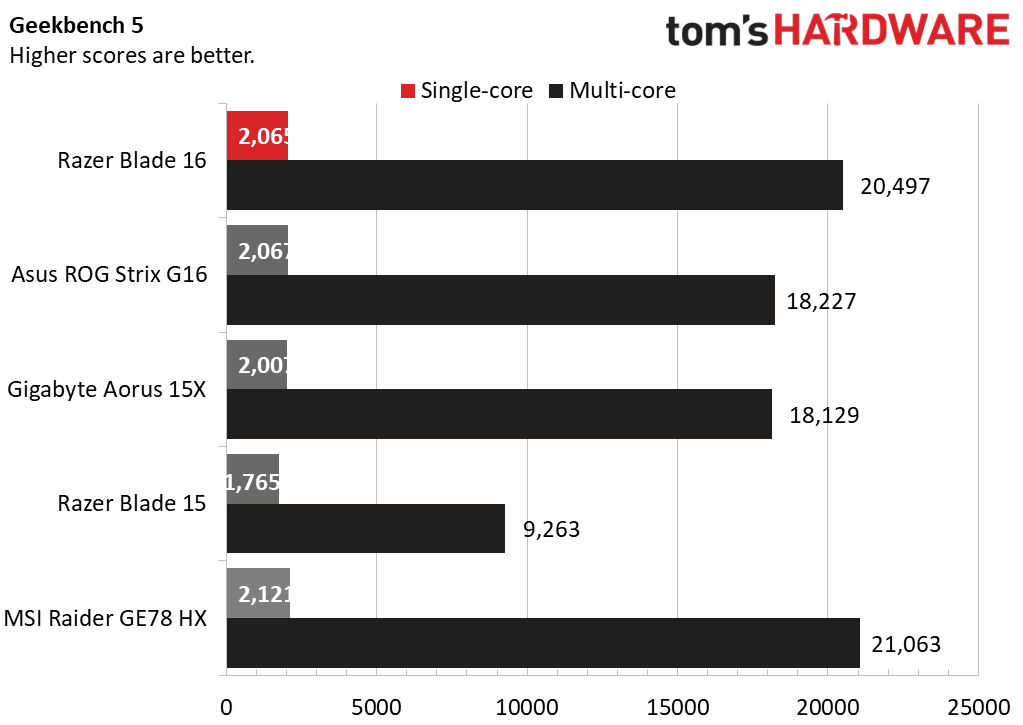
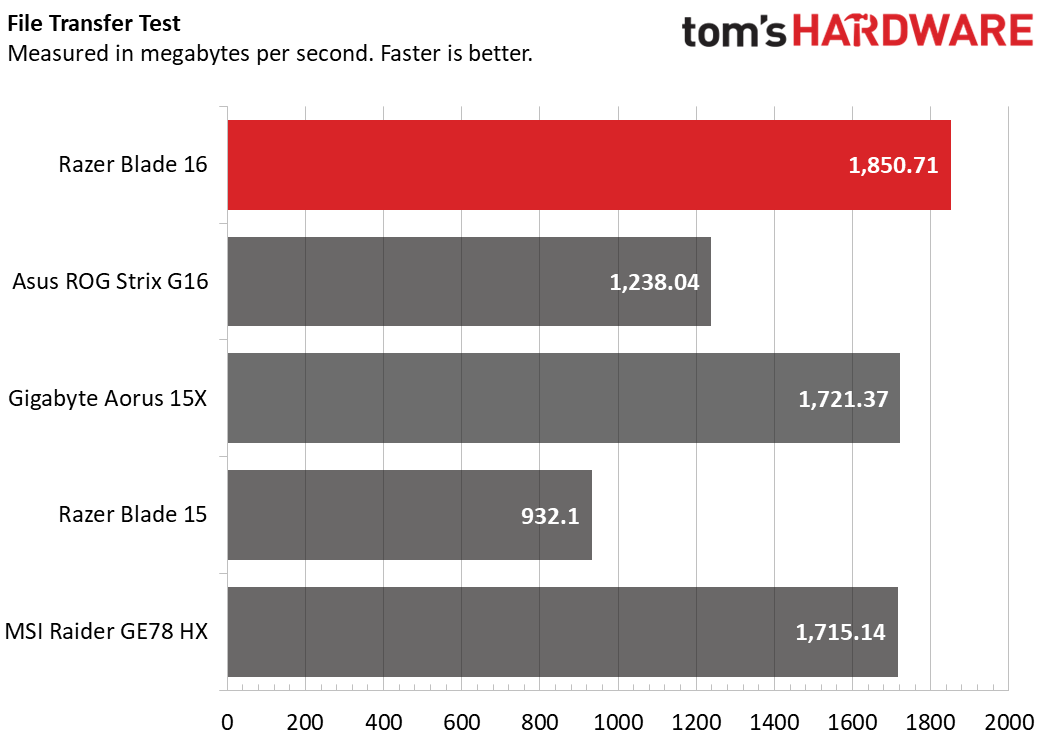

On Geekbench 5, the Blade 16 single-core score of 2,065 bested the Aorus 15x and basically tied the Strix G16. But its multi-core score of 20,497 easily beat everything else here, save for the larger Raider GE78 HX, which wasn't that much higher at 21,063.
The Blade 16 was the fastest at copying our 25GB of files in our file transfer test. At 1,850.71 MBps, it bested swift competition from the Aorus 15X and MSI machines, both of which topped 1,700 Mbs.
On our Handbrake video transcoding test, the Blade 16 again stood out, tying the larger MSI Raider, finishing the task in 4 minutes and 8 seconds. The Strix and Aorus systems were both about a minute slower, suggesting that Razer's cooling and chassis design give it an edge in productivity performance.
Display on the Razer Blade 16
Given the stark price differences between our $3,299 configuration of the Blade 16 and the similarly performing Asus Strix G16 (which is $1,999), not to mention the $2,999 MSI Raider GE78 HX which packs a much more powerful RTX 4080, the screen on the Razer Blade 16 is going to have to do a whole lot of heavy lifting to justify Razer's high price.
And to be fair, it's an interesting panel, with the ability to run at 240 Hz at 1920 x 1200, and 120 Hz at 3840 x 2400. That makes it plenty capable of both serious esports and high-res media consumption or content creation. But beyond esports titles, you'd probably want a higher-end GPU than the RTX 4070 to best take advantage of this screen's options.
And while the colors and accuracy are very good for media consumption or creation tasks, they aren't the best we've seen recently. It does get very bright, though.
The Blade 16 blows past more traditional LCD panels in terms of color, delivering 132% of the sRGB color space, and an impressive 93.7% of the larger DCI-P3 gamut. It's also incredibly bright, at 511 nits in our testing. However, MSI's Raider GE78 HX is even more colorful, bringing 163% of sRGB to the table, and 115.4% of DCI-P3. MSI's screen doesn't get as bright (412 nits in our testing) but it still kicks out quite a bit of light – especially compared to last year's Blade 15, which only managed 232 nits.
The Blade 16's display is very good, and a huge leap both in vibrance and abilities over the screen on the Blade 15. When I watched the trailer for Spider-Man: Across the Spider-Verse , the colors were bold and bright in true comic-book fashion, and the wonderful chaos of the highlights playing across such a vivid screen reminded me of seeing the original in a theater with my family back in 2018.
The other primary feature of the Blade 16's display is its "dual-mode" ability to shift between 3840 x 2400 at 120 Hz and 1920 x 1200 at 240 Hz. In some ways, this gives you the best of both worlds. But to get between those words, you'll have to fire up Razer's Synapse software, flip a switch and then reboot the system. Is that difficult? No, but it's not entirely convenient or intuitive either. And I wonder how often buyers will actually switch between the two options after a few days of playing with the feature and the novelty wears off.
In short, the screen is great. I just don't know that it impressed me enough to justify the cost of the Blade 16 over similarly configured competitors. I'm sure for some, this screen will be worth the expense.
Keyboard and Touchpad on the Razer Blade 16
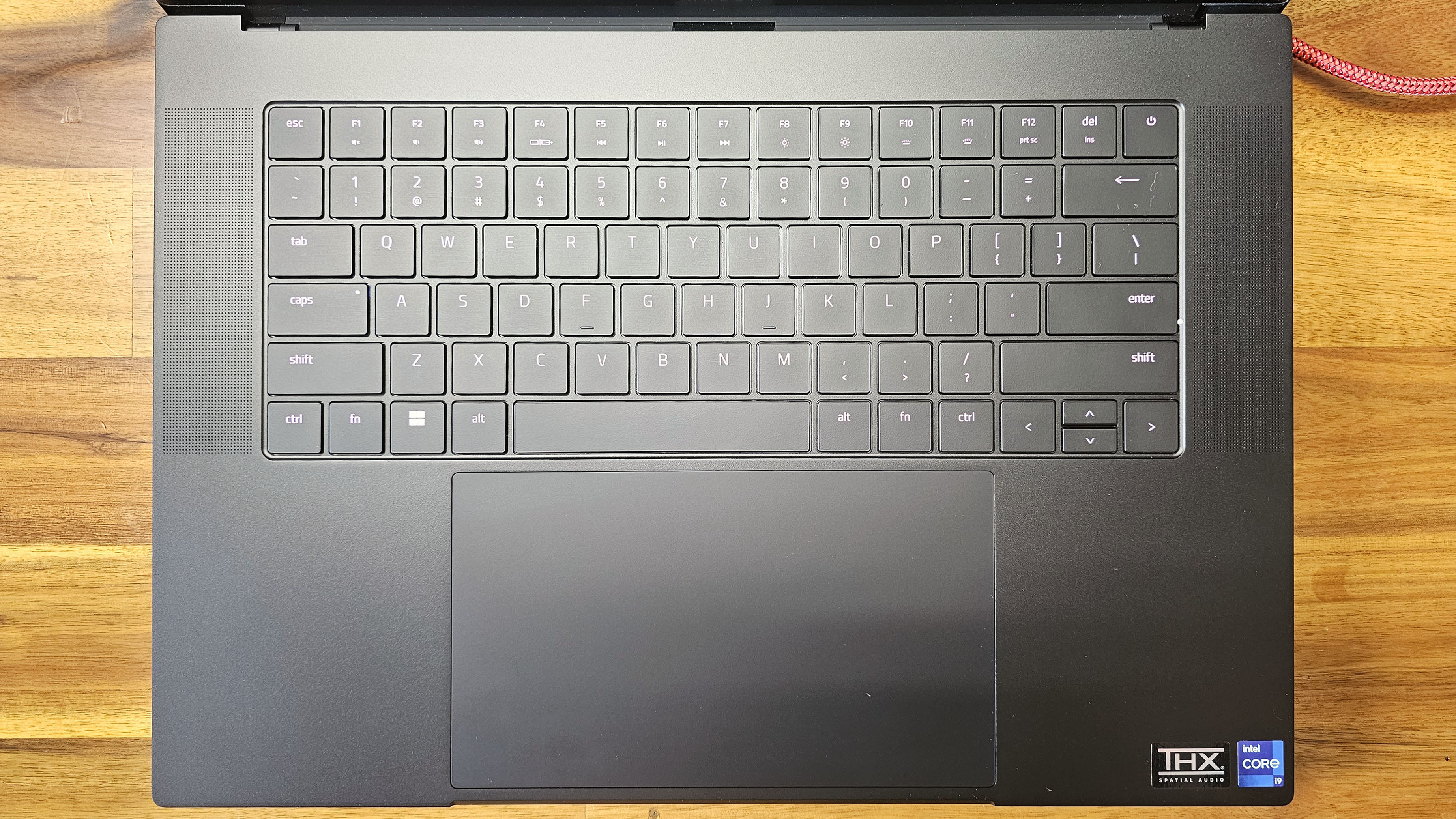
If you've spent time with any Razer laptop in recent years, the keyboard here should feel pretty familiar. The keys are flat and travel is shallow, though not egregiously so. The layout is at least fairly roomy, with only the up/down arrow keys getting significantly squished. I still much prefer the mechanical keyboard options offered on some Alienware and MSI laptops, but for most people, the Blade 15's keyboard will be perfectly fine.
And then there's the massive 7.5-inch diagonal touchpad, which Razer has enlarged seemingly either in emulation of Apple's MacBook Pro or just to make the larger space below the keyboard useful in some way (or maybe both). The touchpad worked flawlessly during my time testing the laptop, although those with huge hands may have issues resting their palms on the bits of the deck that aren't taken up by input devices. It also feels like a touchpad this big would feel better if it were haptic rather than sticking with physical clicks. But while the larger touchpad doesn't feel particularly useful here, I don't have any serious complaints about it in use.
Audio on the Razer Blade 16
The speakers on the Razer Blade 16 should suffice for most people – at least most who don't want to connect speakers or reach for one of the best gaming headsets for more volume and bass. When I listened to the track "She Lies Beyond" from the upcoming Lead Into Gold album The Eternal Preset, the artful and intricate droning and squelching complimented the dreamily drifting vocals well. I noticed no distortion, even at maximum volume. But Paul Barker's drumming and the Cure-like bassline lacked enough low-end that the overall sound was sharp, particularly when turned up high.
I fired up the included THX software to see if I could improve things, but the Music preset was already selected. And I didn't have much luck making things sound better. Still, the audio output feels good enough for most people. It's certainly sufficient for streaming video on the go. And anyone who wants truly great sound should be looking to external audio options, anyway.
Upgradeability of the Razer Blade 16
Provided you have the required tiny Torx screwdriver bit, getting inside the Blade 16 is surprisingly easy. Once I removed the eight screws on the bottom (all of which were helpfully the same length), the base of the laptop lifted right off from the front.
As far as upgrade options, you could swap out the two sticks of DDR5 RAM, and there's a spare M.2 slot that interestingly sits right on top of the pre-installed boot drive. That's good, because Razer doesn't sell the Blade 16 with more than 1TB of storage unless you opt for the top-end RTX 4090 option, which sells for $4,299.
Battery Life on the Razer Blade 16
On our battery test, which continuously browses the web, streams video and runs OpenGL tests while connected to Wi-Fi with the screen at 150 nits of brightness, the Blade 16 lasted 5 hours and 6 minutes. That's slightly better than the Blade 15 (4:54) and slightly less than the Aorus 15X. And the Raider GE78 HX looks particularly bad, hanging on for just 2 hours and 32 minutes. But at 8:459, the Asus ROG Strix G16 steals the show here, making it the best choice for those looking for a gaming laptop that can also be used for long periods when unplugged for basic productivity or streaming content.
Heat on the Razer Blade 16
At the center of the keyboard, between the G and H keys, the Blade 16's keyboard wasn't too warm, at 94.3 degrees Fahrenheit (34.6 degrees Celsius). Although it did get hotter near the top where your fingers don't often sit. The F5-F7 keys got the warmest, at various times in our testing reaching as high as 104.9 Fahrenheit (40.5 C). The touchpad got pretty warm as touchpads go, topping out at 99.5 F (37.5 C) during our gaming stress test, but then you aren't going to be using the touchpad while gaming (I hope).
The hottest point on the bottom of the laptop during our stress testing measured 116.2 degrees Fahrenheit (46.8 C), near the back, in the same area where the middle Function keys are on the top of the laptop. In short, the Blade 16 gets fairly warm for a gaming laptop, but we've seen worse. You'll want to do your long-term gaming at a table or desk.
Webcam on the Razer Blade 16
A 1080p webcam sits above the display, behind a pleasing physical privacy shutter. The camera includes IR for Windows Hello face recognition, and generally it punches above its specs in terms of image quality. I wouldn't expect to use it to take eye-catching selfies, but colors are generally accurate and there's enough detail that I wouldn't find it lacking for important or impromptu video calls.
The camera does lean into over-exposure in bright light, but it's not as bad in that area as what I saw with HP's Dragonfly Pro recently (which, by the way, has a technically higher-end 5MP webcam). This is one of the nicer 1080p webcams I've run across in a laptop, but of course if you want the best quality possible you'll want to pick one of the best webcams instead.
Software and Warranty on the Razer Blade 16
The preinstalled software on the Blade 16 is minimal. You get THX Spatial Audio, an equalizer and audio optimizer for sound tuning, and the company's Synapse software for controlling lighting, customizing micros and more.
Synapse is a capable and slick app that feels far less annoying when it comes pre-installed on a PC it was designed for, rather than on a desktop where you might be nagged to install it repeatedly when you plug in a Razer keyboard or mouse.
Of course, you also get Windows 11 Home, which includes its own bloat, like Spotify, Kindle, TikTok, ESPN and other apps getting shoved at you in the Start menu. Razer sells the Blade 16 with a 1-year warranty, while the battery has a separate two-year warranty of its own.
Configuration of the Razer Blade 16
Razer sells the Blade 16 in five configurations, all of which sport Intel's Core i9-13950HX CPU and Windows 11 Home. The $2,699 base model comes with an RTX 4060, while the $2,999 option steps up to an RTX 4070. Both those configs have 16GB of RAM and a 240 Hz QHD+ (2560x1600) display.
To get the "dual-mode" Mini-LED display, you'll have to spend at least $3,299 for our review configuration, which keeps the 4070 but bumps the RAM up to 32GB. A $3,599 option dials the GPU up to a 4080 but includes the 240 Hz QHD+ screen of the lesser models. And the top-end $4,299 option includes the Min-LED dual-mode screen, an RTX 4090 and 32GB of RAM.
That's right, the only way to get 2TB of storage, at least with the options currently on offer direct from Razer, is to opt for the maxed-out $4,299 configuration. Given the crashing price of SSDs and the ever-increasing size of modern AAA games, limiting almost all configurations to just 1TB of storage is quite unfortunate. Razer isn't alone in this, but anyone spending more than $2,000 on a gaming PC at this point should also get 2TB of storage.
Bottom Line
There's a fair bit to like about the Blade 16, from its second-to-none (or maybe second-to-Apple) chassis design, a surprisingly good webcam, and solid productivity and gaming performance.
The main draw of the Blade 16, though, is its dual-mode Min-LED screen. And while I found it in no way disappointing (other than perhaps the need to reboot to change modes), I don't think for most people the panel will justify the price. For $3,299 in our review configuration with an RTX 4070, it's a hard sell against either the similarly configured Asus ROG Strix G16 for $1,300 less, or the bigger but much more powerful MSI Raider GE78 HX, which packs an RTX 4080 and an impressive screen of its own, for $300 less than the Blade 16, or $2,999.
After a rough start with the Mattel Aquarius as a child, Matt built his first PC in the late 1990s and ventured into mild PC modding in the early 2000s. He’s spent the last 15 years covering emerging technology for Smithsonian, Popular Science, and Consumer Reports, while testing components and PCs for Computer Shopper, PCMag and Digital Trends.
-
PlaneInTheSky If I need performance-on-the-go I just use Shadow.Reply
High-end laptops makes less and less sense now that you can just pull all the performance you want out of the cloud.
Why spend thousands of $ on a heavy expensive laptop that drains battery life when you can just use a light $300 laptop and get your performance from the cloud without draining your battery. -
saunupe1911 No longer worth it. Asus has caught up in every category.Reply
But most importantly Razer's support is downright horrible. It's actually unacceptable for a machine of this cost.
I literally told them that their support processes will limit their growth as they won't retain customers. -
thisisaname <laughs> price in the sub headline $3,299 price in the advert in the Tom's Hardware verdict box around 2700 give or take a dollar or two, that is quite a discount. :geek:Reply
